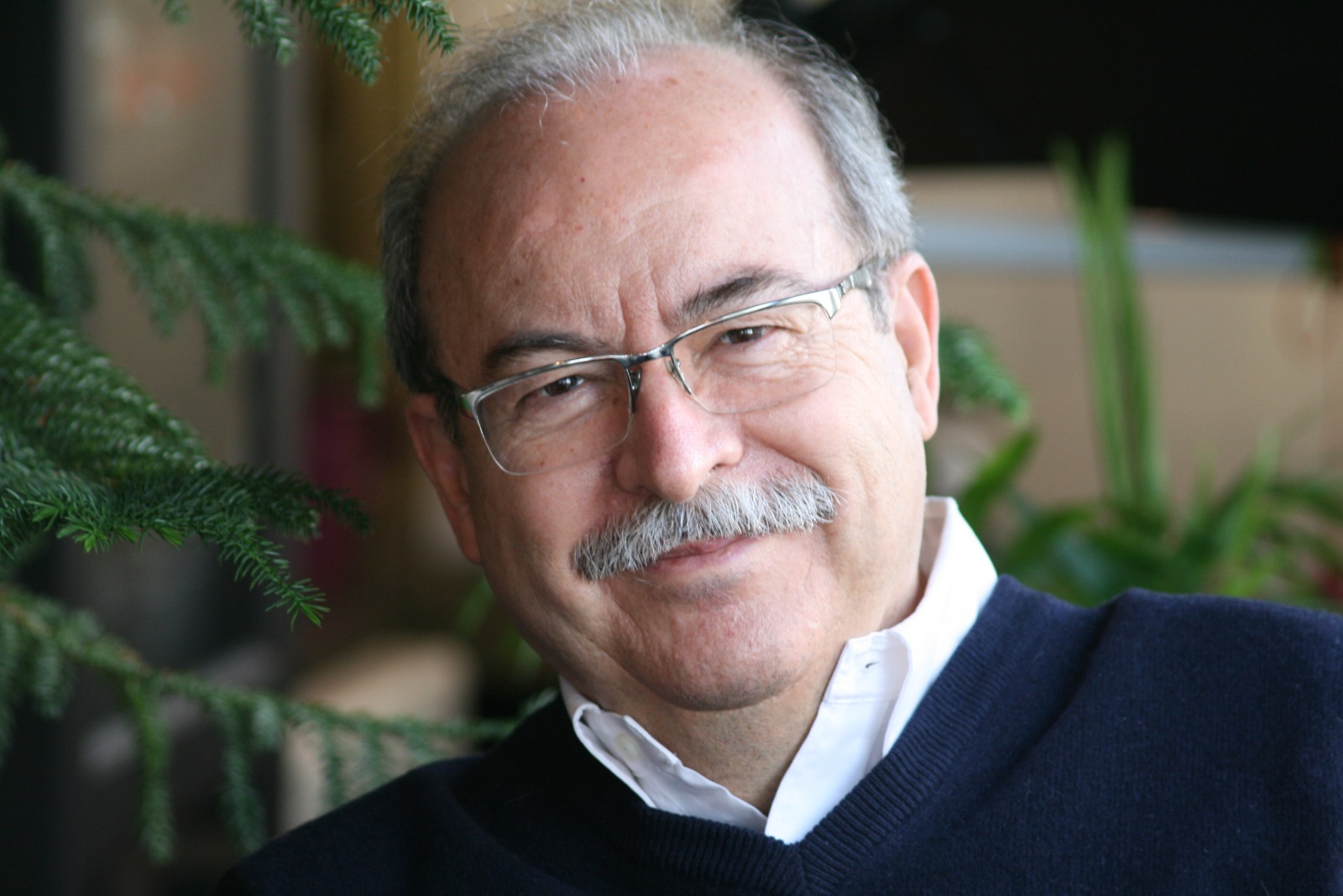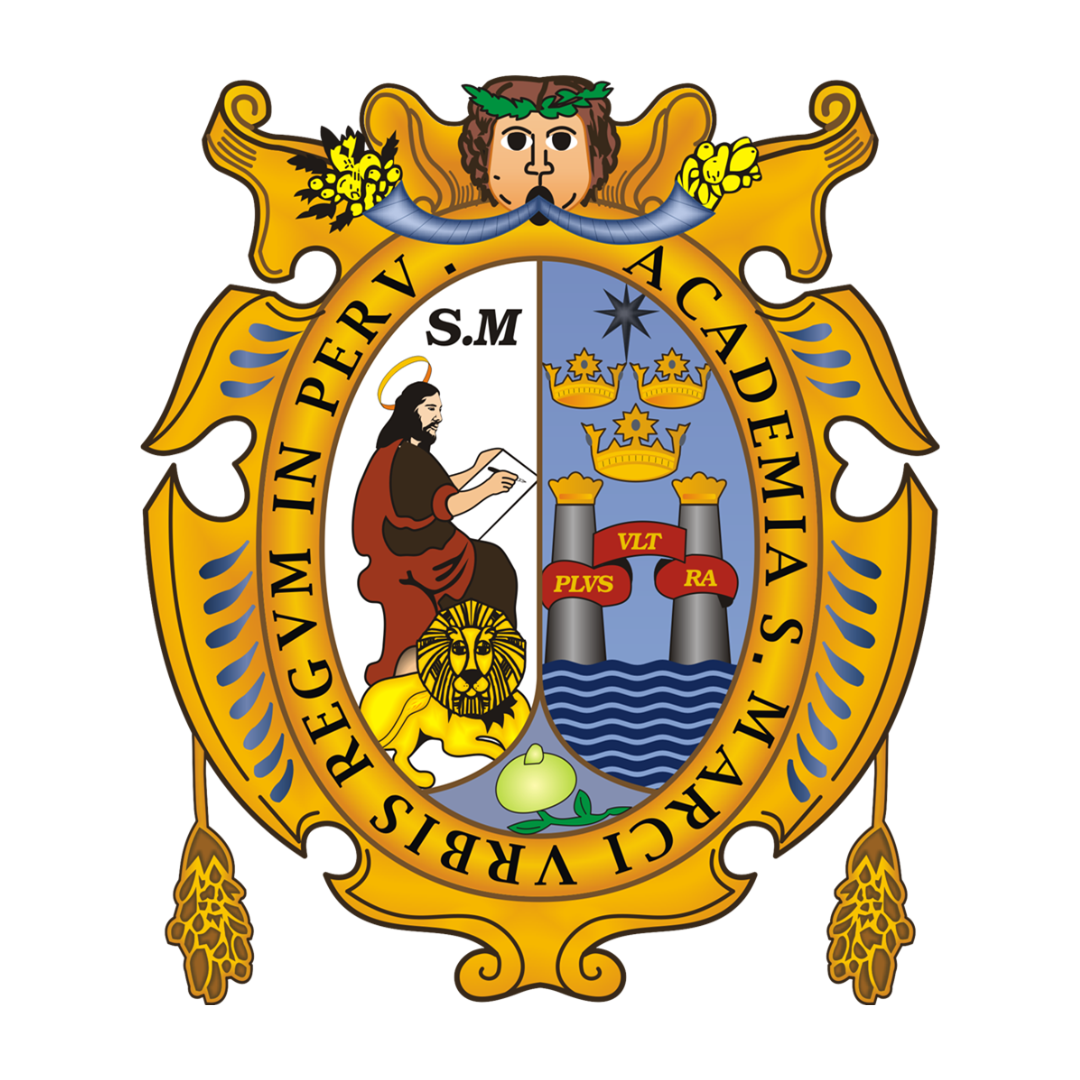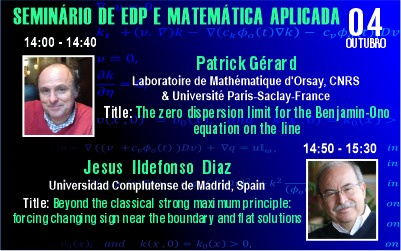Seminar in EDP and Applied Mathematics
october 4 , 2023 – 14h (Brazil)
Streaming: Youtube Channel | SEMINARIO DE EDP E MATEMATICA APLICADA
Event

About Seminars
Our Online Seminar is one of the most important events in Brazil, it has been held since August 2020, every Wednesday at 2 pm, Brasília time, with a frequency of 14 days. Two 40-minute lectures are presented in each session. Our speakers are world-renowned mathematicians from Europe, the United States and South America.
Featured Talks & Speakers

Patrick Gerard
Laboratoire de Mathématique d’Orsay, CNRS & Université Paris-Saclay-France
14:00h – 14:40h
The zero dispersion limit for the Benjamin-Ono equation on the line

Jesus Ildefonso Diaz
Universidad Complutense de Madrid, Spain
4:50h – 15:30h
Beyond the classical strong maximum principle:forcing changing sign near the boundary and flat solutions
In a pioneering paper, on 1910, S. Zaremba established the \textit{strong maximum principle} saying that if $\Omega$ is a smooth bounded domain in $% \mathbb{R}^{N}$ and a function $u$ verifies \begin{equation}\left\{\begin{array}{lr} -\Delta u\geq f(x) & \text{in }\Omega , \\u=0 & \text{on }\partial \Omega ,%\end{array}%\right. \label{ProbLineal}\end{equation}% \noindent then \begin{equation} u(x)>0\text{ in }\Omega , \tag{P$_{u}$} \label{Positiv u} \end{equation} \noindent assumed that \begin{equation} f(x)\geq 0\text{ in }\Omega ,\text{ }f\neq 0. \tag{P$_{f}$} \label{Positiv f} \end{equation} The extension to a more general second order elliptic operator was due to E. Hopf, on 1927. Moreover, some years later, on 1952, E. Hopf and O.A. Oleinik, independently, proved that under the above conditions the normal derivative of $u$ satisfies the following sign condition \begin{equation} \frac{\partial u}{\partial n}<0\text{ on }\partial \Omega . \label{Hypo2.3} \end{equation}. The main goal of this lecture is to show that the non-changing sign assumption (\ref{Positiv f}) can be removed in a suitably way (for instance when $f(x)<0$ in some neighborhood of $\partial \Omega $)$.$ Under such type of new assumptions on $f$ we can prove that: (A) the positivity of $u,$ property (\ref{Positiv u}), still holds and $% \frac{\partial u}{\partial n}\leq 0$ on $\partial \Omega ,$ \noindent and (B) under additional conditions on $f(x)$, the positive \textit{solution} of the equation (\ref{ProbLineal}) [i.e., now with the identity symbol $=,$ instead $\geq $] does not satisfy (\ref{Hypo2.3}) but $\frac{\partial u}{% \partial n}=0$ on $\partial \Omega $ \ (this corresponds to the notion of \textit{flat solutions} already considered by different authors in the framework of some nonlinear problems). The above extension of the strong maximum principle admits many generalizations (nonlinear elliptic operators, zero and first order terms, etc.). In the case of linear parabolic problems%\[ \left\{\begin{array}{lr} u_{t}-\Delta u=f(x,t) & \text{in }\Omega \times (0,+\infty ), \\ u=0 & \text{on }\partial \Omega \times (0,+\infty ), \\ u(x,0)=u_{0}(x) & \text{on }\Omega ,% \end{array}% \right.\]% it can be proved that, under suitably changing sign conditions on $u_{0}(x)$ and/or on $f(x,t)$ (even if it occurs for any $t>0$), we get the global positivity of $u(x,t)$ on $\Omega $, for large values of time ( $\exists $ $% t_{0}\geq 0$ such that $u(x,t)>0$ a.e. $x\in \Omega ,$ for any $t>t_{0}$). An application to some \textit{sublinear} \textit{indefinite} semilinear equations will be also given. [Joint results with Jes\'{u}s Hern\'{a}ndez].
About Organization
Juan Limaco – UFF – Brazil (Coordenador);
Mauro Rincon – UFRJ – Brazil
Max Souza – UFF – Brazil;
Sandra Malta – LNCC – Brazil
Marcelo Cavalcanti – UEM – Brazil;
Rui Almeida – UBI – Portugal
Roxana Lopez – UNMSM – Peru;
Diego Souza – U Sevilla – España;
Mauricio Sepulveda – UdeC – Chile;
Roberto Capistrano – UFPE – Brazil.
Our Partners








Access our channel!
A channel for students, professors, researchers and professionals who wish to deepen their knowledge in EDP and applied mathematics.

